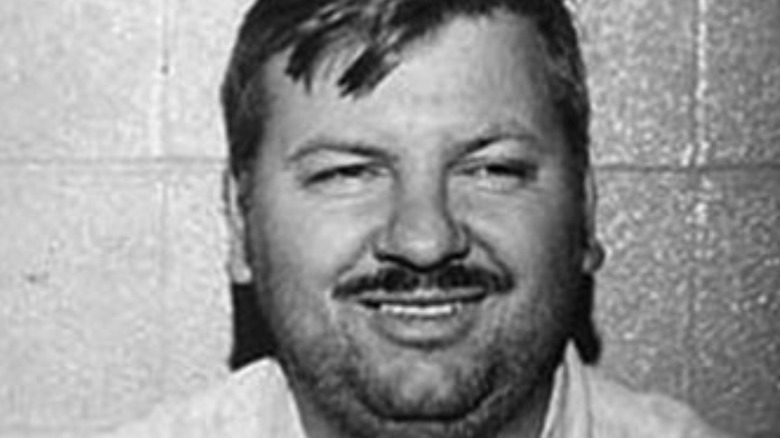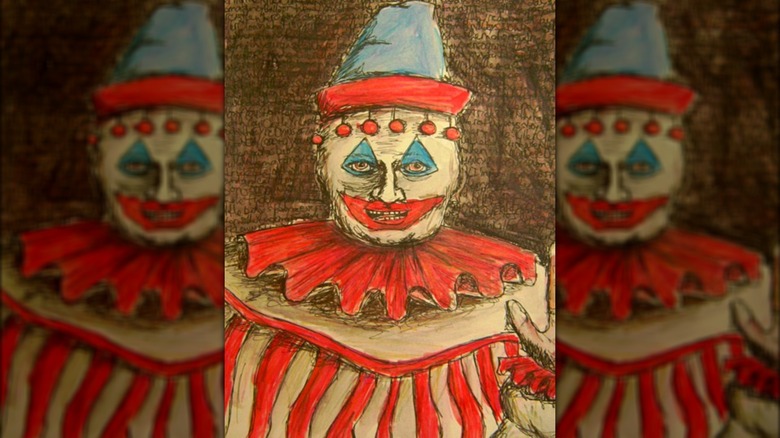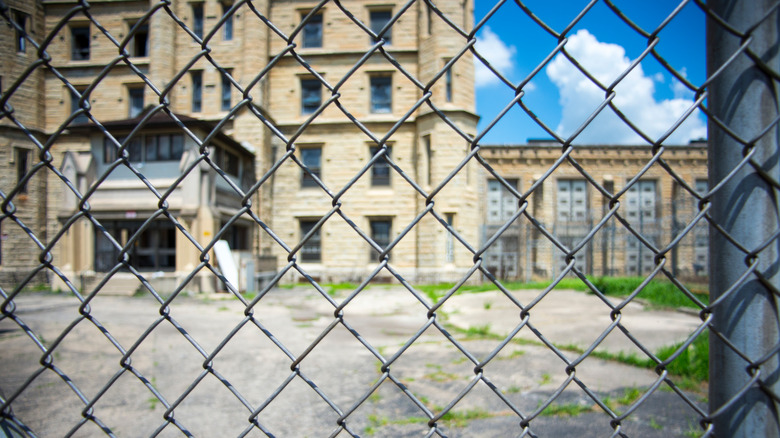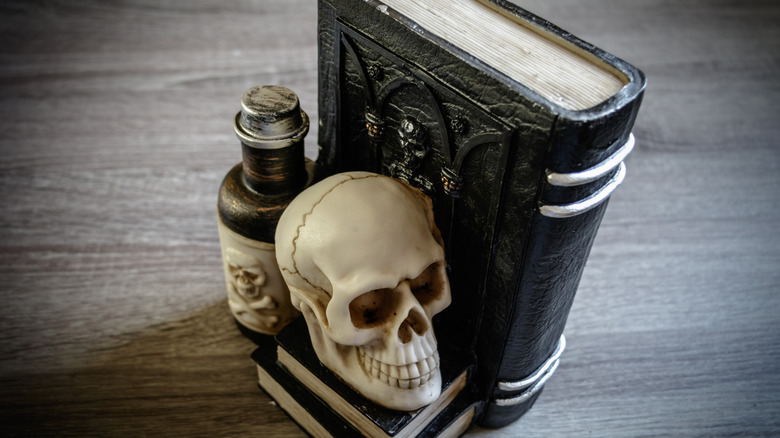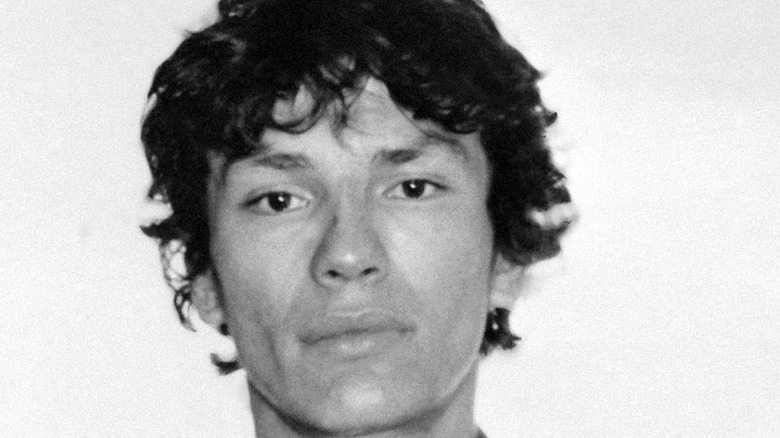The Disturbing Art Made By John Wayne Gacy While On Death Row
John Wayne Gacy, also known as the "Killer Clown" is thought to have murdered 33 young men in the 1970s (via Biography). Horrifically, he hid their remains in a crawl space inside of his Chicago home. Although Britannica writes that Gacy had a long history of sexual violence against teenage boys, the killings and the subsequent discoveries of the bodies, shocked his suburban neighborhood and those who thought they knew him. According to All That's Interesting, Gacy was well-liked and active in his community. He enjoyed entertaining children under the name "Pogo the Clown."
Additionally, the Culture Trip reports that at one point, he worked in construction and at a KFC. He was also married twice and had two children. In other words, Gacy made himself out to be an average Midwestern man. This, however, could not have been further from the truth. In actuality, Gacy was perverse, sadistic, and a pedophile. Moreover, he struggled to accept his homosexuality. ThoughtCo explains that he assaulted and tortured his victims, some of them were as young as 15.
Another article from All That's Interesting states that he was able to lure young men into his home under the guise of job offers, parties, and more. He would then proceed to attack and strangle them. Gacy was caught when police discovered he had last been seen with a missing boy named Robert Piest (per Biography). Ultimately, his house of horrors was uncovered and Gacy was put on trial.
John Wayne Gacy's life on death row
According to ThoughtCo, Gacy's trial began on February 6, 1980. He had brazenly confessed to dozens of murders during his arrest. Although Gacy had tried to plead insanity, the jury dismissed this claim. Biography writes that he was found guilty of 33 murders and was later sentenced to death. However, All That's Interesting reports that it would be years until Gacy was executed. In the meantime, he took up a surprising new hobby; painting. According to the Crime Museum, Gacy was given a paint set while he was on death row in 1982. He subsequently created 2,000 works of art.
Per Distractify, Gacy's art is colorful and at times, personal. Several of his pieces are of his persona, "Pogo the clown" or self-portraits. Furthermore, some feature cartoons, such as the seven dwarves from "Snow White." All That's Interesting reports that other paintings include depictions of skulls, Jesus, various pop culture icons, and landscapes. Interestingly, he painted other famed criminals like Charles Manson and Ed Gein (via Sinister Isles). Gacy stated that his intention when it came to painting was "to bring joy to people's lives." Nonetheless, he was making hundreds of dollars from his new venture all while he was stuck in a prison cell.
John Wayne Gacy's prison business
Sinister Isles states that Gacy began selling his art when his lawyer introduced him to Andy Matesi in 1980. According to Time Out, Matesi was the owner of Splish-Splash Collectibles in Chicago. Gacy's lawyer saw that he was selling a picture of Charles Manson and eagerly asked Matesi "How would you like to collect another serial killer: John Wayne Gacy?" Matesi and Gacy quickly got into contact and began a business partnership and friendship. Matesi visited Gacy in prison several times and bought his art off of him using a money order.
Matesi would then sell it in his shop for a higher price. The business was lucrative to say the least. The Crime Museum writes that Gacy was eventually sued by the state of Illinois in an effort to prevent him from making money from his artwork. In fact, A&E explains that once his looming execution date got closer, Gacy was less concerned about dying and more concerned about financial matters; he wanted to ensure his profits went to his family.
The case was later thrown out and John Wayne Gacy was executed by lethal injection shortly after on May 11, 1994. As for Matesi, he continued selling Gacy's paintings long after his death. Time Out reports that he sold two of his pieces for $5,000 back in 2010.
What happened to the rest of his art?
Shortly after Gacy's death, some of his work was successfully auctioned off, per the Crime Museum. All That's Interesting writes that in 2011, the Arts Factory Gallery in Las Vegas had an exhibit of Gacy's work. Several of the pieces, including some depicting Charles Manson and Elvis, were being sold for $2,000 to $12,000. According to CNN, the exhibit stated that it was going to benefit the National Center for Victims of Crime. However, the group expressed that they were not interested in their charity and sent a cease-and-desist letter to the gallery.
Westly Myles, the owner of the Arts Factory replied by saying "People can think what they like, I see it as an opportunity to help from something that was bad." Sinister Isles reports that in June, 1994, several relative's of Gacy's victims got together to burn his paintings in Naperville, Illinois. The idea came from Joseph Roth and Walter Knoebel, two men who spent thousands on Gacy's art for family members to burn. Those who participated cheered as the art went into the flames and described the experience as cathartic.
Distractify states that several of Gacy's paintings are still in circulation and selling for thousands of dollars. Although his family does not make any revenue from it, it can still be said that someone is profiting from Gacy's brutal crimes. In 2018, it was reported that his art could sell from $6,000 to $175,000 (via Observer).
The rise of murderabilia
In 2020, Gacy's art made news again when famed TV personality and paranormal investigator Zak Bagans announced he had purchased several of his paintings (via TMZ). Bagans bought them off of Tammy Hoff, Gacy's stepdaughter. Additionally, he acquired letters, a polaroid photo, and Gacy's last pack of cigarettes. Bagans stated that he intended to display these items at his Haunted Museum in Las Vegas. According to All That's Interesting, Bagan's is not the only one interested in this so-called murderabilia. This market, which is centered on items related to violent crimes, is said to generate thousands each year.
The Observer reports that the term was murderabilia devised by victim's right advocate Andy Kahan in 1999. Since then, serial killer art and relics have become a hot commodity. Why is Gacy's art so popular and expensive? One art dealer, William Harder, explained that "The more vicious the case, the higher the body count, certainly the more celebration in the press, the more a painting or drawing is going to be worth."
Although Gacy endorsed the sale of his artwork, others serial killers like "Son of Sam ” David Berkowitz, do not want murderers profiting from their crimes. He has gone on to say that he finds the concept revolting (per Oxygen). Interestingly, Berkowitz is partially responsible for the "Son of Sam law" which was enacted in New York to prevent criminals from making money regarding their transgressions.
The other serial killers that became artists
According to Distractify, Gacy is not the only notorious killer to have become an artist while in prison. Others include Charles Manson and Richard Ramirez (seen above). The Observer reports that after Gacy, their artwork is the most sought out. Kahan notes that many serial killers don't start creating artwork until after their time in prison. As he put it "You get reborn and you turn into DaVinci." Per Unusual Universe, others like Dennis Rader, Henry Lee Lucas, and Elmer Wayne Henley all turned to making art. Radar specifically was known for creating disturbing drawings of women. He was later prohibited from doing so.
Psychology Today writes that "Happy Face Killer” Keith Jesperson faced legal repercussions when he started to sell wildlife drawings he made by tracing copyrighted photos. Jesperson was selling them for $10 to $25 and is believed to have made $1,000. Who is buying this murderabilia? The observer writes that everyone and anyone all over the world, including children and celebrities like Johnny Depp.
As for the ones who sell it, one dealer, Eric Gein told ABC News that he has to form a relationship with these criminals in order to sell their art. He also stated that he finds no guilt over it. As he explained "I am desensitized to the crimes. When I'm in contact with these guys, I'm not thinking, 'Wow. This guy destroyed 30 families.' I'm thinking, 'This guy can make me money.'"
